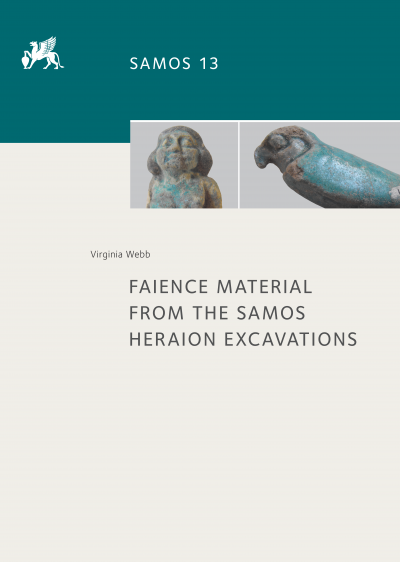Faience Material from the Samos Heraion Excavations
https://doi.org/10.34780/660a-dk50
##submission.synopsis##
The Heraion on Samos has been known since excavations began in the early nineteen hundreds as the findplace of exotic and unusual objects for the goddess Hera, brought from regions outside Greek lands, both East and West, dedicated in the sanctuary and finally buried in deposits of ex-votos. This long awaited study of the objects made of faience complements previous major studies in the Samos series on Cypriot limestones and terracottas (Schmidt) and Egyptian and Near Eastern bronzes (Jantzen) to which we should add Near Eastern and Egyptian ivories (Freyer-Schauen-burg) published by the University of Hamburg.Faience is a colourful and attractive material used for both perfume vessels, figurines, and amulets, but its manufacture is alien to Archaic Greece. Thus it forms part of the interchange of imported technologies and styles which characterises the Orientalising movement in Greece, and it illuminates new routes of contact between Greece and the old world of Egypt and the Near East. Faience objects of unmistakable Egyptian origin come from the Heraion (though they are in the minority). But the greatest number are those which belong to the first two phases of the faience industry, estab-lished in East Greece in the second half of the seventh century: in particular they include a large body of figurines which clearly reference foreign cult. The strongest influence on these faience objects comes from the Egyptian sphere, although the exact path this took is still unclear, and other probably Near Eastern influences are also detectable. Samos has already yielded a large number of high quality Egyptian bronzes of XXV/XXVIth Dynasty date, which are the subject of much discussion as to their purpose and dedication. Virginia Webb has an unrivalled knowledge of the faience objects and their context in the East Greek and Egyptian worlds and this book promises to expand our knowledge of this important but up to now little known aspect of the foreign dedications in the Heraion.
##submission.chapters##
-
1 General IntroductionFaience in Egypt – Faience and Other Materials Found in the Heraion on Samos
-
2 Egyptianizing Workshops in East GreeceThe »Low Relief« Style with Incised Figure Decoration – »Leopard Spot Group«: Vases in Form of a Kneeling Figure – Disparate Groups: Vases in Form of Kneeling Woman With Baby at Back and Ibex on Lap – Varia
-
3 Genuine Egyptian FabricsDecorated or Plastic Vases for Oil, Nile Water or Kohl – Amulets and Talismans – Ornaments and Jewellery – Varia
-
4 Egyptian BlueHistory of the Material – The Material and Technique – History of Its Use – Finds at the Heraion – Vessels – Scarabs – Amulet – Conclusion
-
5 Human Figurines: Greco-Egyptian WorkshopsStatuettes in Human Form – Identity of Figurines – Faience as a Material for Small Scale Statues in Egypt – Male Figures without Attributes – Male Figures with Offerings or Playing Instruments – Female Figures – Male and Female Seated, Side by Side – ...
-
6 Animal Figurines: Greco-Egyptian WorkshopsLarge Figurines on Stands, without Suspension Loops – Small Figurines on Stands, with Suspension Loops
-
7 Falcon Figurines: Greco-Egyptian WorkshopsLarge Figurines on Stands, without Suspension Loop – Small Figurines on Stands, with Suspension Loop
-
8 Stone Figurines and Glazed Clay VasesStone Figurines – Glazed Ware Vases
-
9 ConclusionsThe Faience Corpus from the Samos Heraion
-
10 AppendixList of Findplaces of Faience Objects in the Heraion – Indices – Abbreviations – Bibliography –Sources of Illustrations – Plates 1–43




